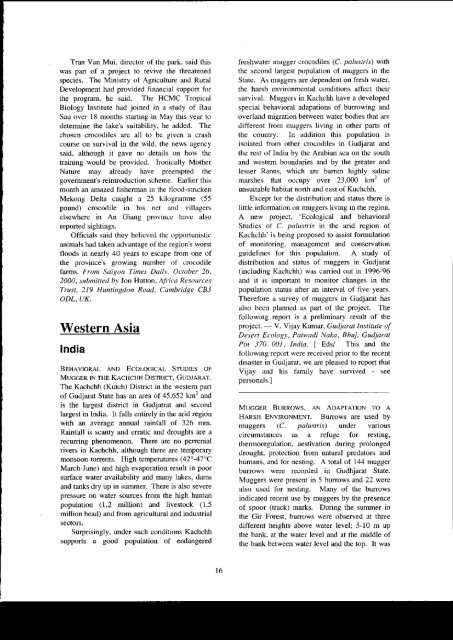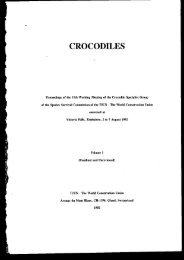size: 1779KB - Crocodile Specialist Group
size: 1779KB - Crocodile Specialist Group
size: 1779KB - Crocodile Specialist Group
You also want an ePaper? Increase the reach of your titles
YUMPU automatically turns print PDFs into web optimized ePapers that Google loves.
Tran Van Mui, director of the pa*. said this<br />
was part of a project to revive the threatened<br />
species. The Ministry of Agriculture md Rural<br />
Development had provided financial suppofi fbr<br />
the program, he said. The HCMC Tropical<br />
Biology Institute had joined in a study of Bau<br />
Sau over l8 months sta.rtiDg in May this year to<br />
determine the lake's suitability, he added. The<br />
chosen crocodiles are all to bc Biven a crush<br />
course on survival in the wild. the news agency<br />
said, although it gave no details on how the<br />
training would be provided. Ironicully Mother<br />
Nature may aheady have preempted the<br />
goverrunent's reintroduction scheme. Earlier this<br />
month an anazed fisherman in the llood-stricken<br />
Mekong Delta caught a 25 kilogramme (55<br />
pound) crocodile in his net und villageni<br />
elsewhere in An Giang province have also<br />
reponed sightings.<br />
Officials said they belicvcd thc ()pp()rtuni\tic<br />
uurimals had tnken ndvantage of the regio['s worst<br />
floods in nearly 40 years to escape tiom one of<br />
the province's growing number of cnrcodile<br />
farms. Fntm Sedgon T'imes Deilv. October 26,<br />
2000, submitted by Jon Hutton. Afiica Resai, cc.r<br />
Trust, 219 Huntingdon Roatl, Cambridge CB3<br />
ODL, UK.<br />
Western Asia<br />
lndia<br />
BEHAVIoRAL AND ECOL0GICAL STUDES OF<br />
MUGGER IN THE KACHCHH DISTRIcT. GUDJARAT.<br />
The Kachchh (Kutch) District in the westem part<br />
of Gudjarat State has an area of 45.652 km: and<br />
is the largest distdct in Gudjatrat and second<br />
largest in lndia. It talls entirely in the arid region<br />
with an average annual rainfall of 326 mm.<br />
Raintall is scanty and eratic ar]d droughts a]e a<br />
recurring phenomenon. There are no perrenial<br />
rivers in Kachchh, although there are temporary<br />
monsoon torrents. High temperatures (42"-47"C<br />
Mdrch-June) and high evaporation result in poor<br />
surface water availabitity and many lakes, dams<br />
and tanks dry up in summer. There is also seyere<br />
pressure on water sources from the high human<br />
population (1.2 million) and livestock (1.5<br />
million head) and tiom agricultural and industrial<br />
sectors.<br />
Surprisingly, under such conditions Kachchh<br />
supports a good population of efldangered<br />
freshwater mugger crocodiles (C. palustris) wrth<br />
the second largest population of muggeN in the<br />
State. As muggers are dependent on fresh water,<br />
the halsh environmental conditions aflect their<br />
survival. Muggers in Kachchh have a developed<br />
special behavioral adapations of burowing and<br />
overland rnigration between water bodies that are<br />
difterent fnrm muggers living in other pa s of<br />
the country. In addition this population is<br />
isolated fiom other crocodiles in Gudjarat and<br />
the rest of India by the Alabian sea on the south<br />
and western boundaries and by the greater and<br />
lesser Ranns, which are barren highly saline<br />
marshes that occupy oyer 23,000 kn2 of<br />
unsuitable habitat nonh and east of Kuchchh.<br />
Except firr the distribution lmd status there is<br />
little infomation on muggers living in the region.<br />
A new project, 'Ecological and behavioral<br />
Studies of C. palusttis in the ndd region of'<br />
Kachchh' is being proposed to assist fomulation<br />
of monitoring. management and conservation<br />
guidelines tor this population. A study of<br />
distribution and status of muggers in Gudjarat<br />
(including Kachchh) was caried out in 1996-96<br />
and it is important to monitor changes in the<br />
population status after an interval of live yea$.<br />
Therefore a survey of muggers in Gudjarat has<br />
also been plamed as part of the project. The<br />
following report is a preliminary rcsult of the<br />
project. - V. Vijay Kumar, Gazftfttt ltrstitute of<br />
Desert Ecolog-,-, Patv,,qdi Nakq, Bhuj, Gudjarat<br />
Pin 370 001. India. I Edsl This and the<br />
li)llowing report were received prior to the recent<br />
disaster in Gudjarat, we are pleased to report that<br />
Vijay and his family have survived - see<br />
personals.l<br />
Muc'C;ER BuRRows. AN ADAyTATTON To A<br />
HARSH ENVRoNMENT. Burrows are used by<br />
muggers (C. palustris) under vadous<br />
circumstances as a refuge for resting,<br />
thermoregulation, aestivation during prolonged<br />
drought. protection from natural predators and<br />
humans, and for nesting. A total of 144 mugger<br />
burrows were recorded in Gudhjarat State.<br />
Muggers were prcsent in 5 burows and 22 were<br />
also used fbr nesting. Many of the burrows<br />
indicated rccent use by muggers by the presence<br />
of spoor (track) marks. During the summer ln<br />
the Gir Forest. burrows were observed at three<br />
different heights above water level; 5-10 m up<br />
the bank. at the water level and at the middle of<br />
the bank between water level md the top. lt was<br />
l6
















